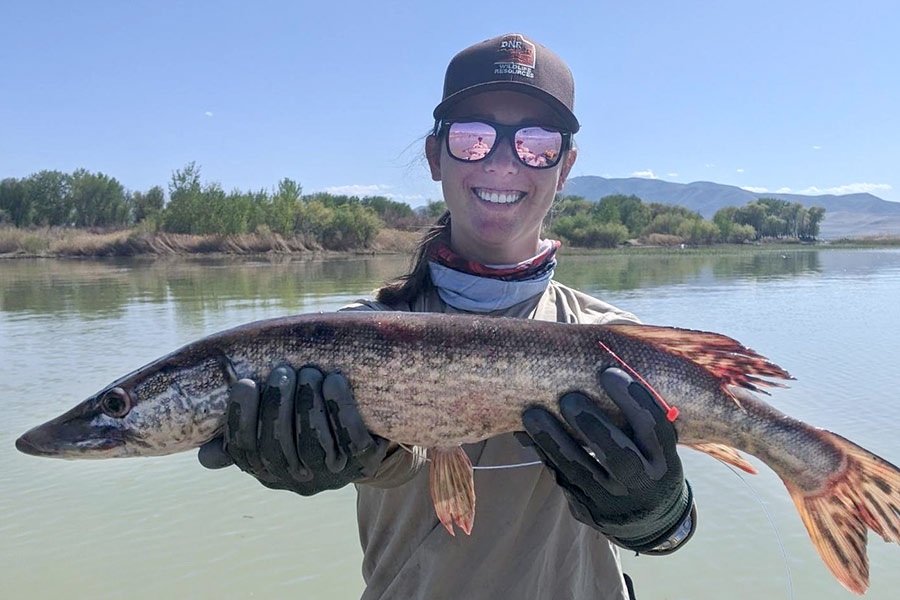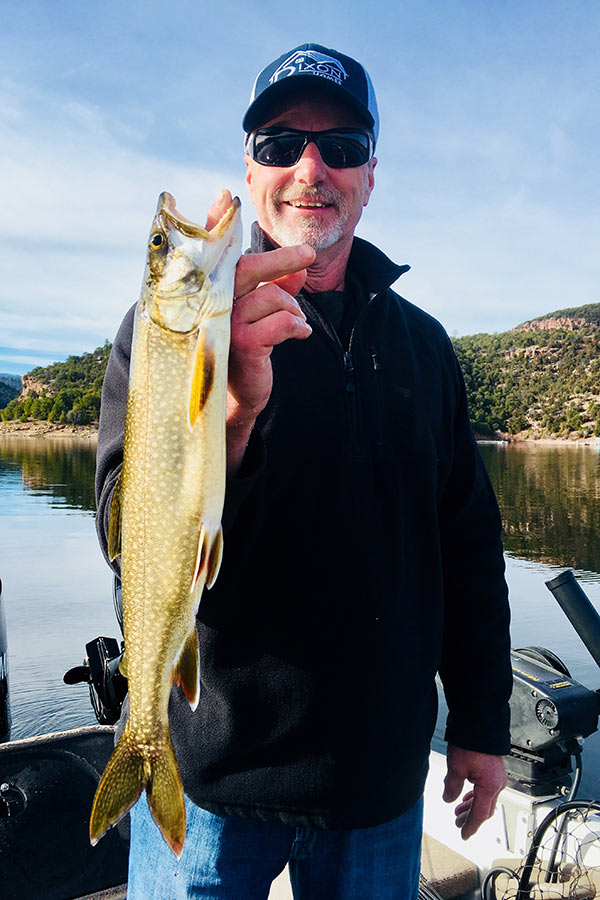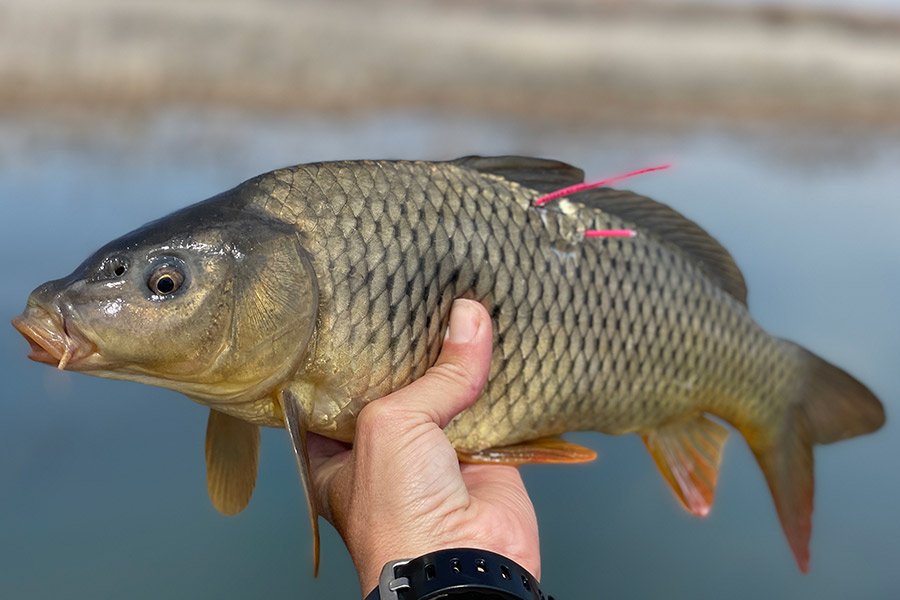3 waterbodies where Utah anglers should target, remove specific fish
Salt Lake City — In an effort to help other fish species and to collect data from tagged fish to help with management decisions, the Utah Division of Wildlife Resources is asking anglers to target and remove specific fish species in three waterbodies across Utah.
DWR fisheries managers use data when setting fishing regulations and stocking rates at various waterbodies around Utah. Sometimes, that data is collected through fish tagging efforts. When anglers catch tagged fish, it is important that they report it to the DWR so that specific data can be collected, which helps biologists make informed decisions about the overall management of the fishery.
Northern pike in Utah Lake
Northern pike were first detected by the DWR in Utah Lake in 2011. Because pike are predatory and reproduce rapidly, biologists are worried about the effect they will have on some of the other fish species in the lake. June suckers — a threatened fish only found in Utah Lake and its tributaries — are of particular concern due to their precarious status, but pike have the potential to impact sportfish in the lake such as walleye, white bass and yellow perch.
As part of an ongoing study launched in 2020, the DWR is still asking anglers to report and release any tagged northern pike they catch in Utah Lake. And, because the invasive fish were placed in Utah Lake illegally, anglers must kill any pike they catch that don't have a tag.
DWR biologists started implanting transmitters in some of the Northern pike in Utah Lake and its tributaries in February 2020 as part of a study to learn more about the seasonal locations and movements of juvenile and adult pike in Utah Lake, the Provo River, Hobble Creek and the Spanish Fork River. The telemetry study is being conducted by the consulting firm Marsh and Associates with assistance from the DWR and is expected to run until 2025.
Since Northern pike typically spawn when the ice begins to melt, anglers may catch more of the invasive fish at Utah Lake this time of year. Anglers can identify the tagged pike by the thin, red tags (made of plastic) attached to them. Tagged fish have been implanted with transmitters so biologists can track them using GPS technology. Surgical scars should be visible on their underside in the unlikely event that the external tag is dislodged, and many tags have a trailing wire to increase their detection range that will be clearly visible.
"We are asking anglers to release pike that have these tags because the transmitters that are in the fish enable us to track their movements," DWR Central Region Native Aquatics Biologist Keith Lawrence said. "Tracking their movements will help us develop a monitoring and control program for Northern pike in the future, which will help protect and manage both threatened June suckers and desirable sportfish."
If you catch a tagged pike in Utah Lake or one of its tributaries, you should do the following:
- Call DWR native fish biologist Keith Lawrence at 801-960-5220
- Report the date and exact location where you caught the fish
- Report the tag number
- Release the fish unharmed
As in the past, if you catch a pike that doesn't have a tag, you must remove the fish from the water and kill it.
Small lake trout at Flaming Gorge
The DWR and Wyoming Game and Fish are asking for anglers to keep any lake trout under 25 inches that are caught at Flaming Gorge Reservoir, in an effort to improve the health of the fishery.
Currently, the popular reservoir in northeastern Utah — known for producing some of the largest lake trout in the U.S. — has too many small lake trout in it. In Flaming Gorge, lake trout larger than 25 inches primarily consume kokanee salmon and rainbow trout. If the abundant population of smaller lake trout (under 25 inches) is not reduced, there could be impacts on the salmon and rainbow trout populations, as well as fewer fish to feed the trophy lake trout.
Last fall, both agencies tagged and released 540 lake trout in the reservoir that were less than 28 inches long. The 2-inch tags are orange and include a phone number and identification number. Upon catching a tagged lake trout, the angler should call and report the catch. The angler will be able to learn when and where the fish was originally tagged and if it's a reward tag, they could receive up to $50.
"The rewards incentivize harvest, but more importantly, when anglers report the catch of tagged fish — regardless of whether the fish has a reward assigned to it — it allows us to calculate the a population estimate and the numbers of fish that are harvested by anglers," DWR Fisheries Biologist Ryan Mosley said. "At Flaming Gorge, we are trying to determine how many small lake trout we have and how many need to be removed to achieve healthier overall fish populations. In this instance, the reward tag data also lets us know whether our current fishing regulations and angler harvest will achieve that desired end goal of decreasing the population of smaller lake trout in the reservoir."
Angler harvest can be an effective tool for managing fisheries. Harvesting and reducing the number of smaller lake trout would provide more food for the remaining fish to eat, which would do two positive things:
- Allow more kokanee salmon and rainbow trout to survive so there are more for anglers to catch (because smaller lake trout not only prey on but may also compete with kokanee salmon and rainbow trout).
- Allow the remaining lake trout to grow faster and larger (because kokanee salmon and rainbow trout are the primary fish the trophy lake trout prey on).
The lake trout daily limit is 12 lake trout, with only one of the fish exceeding 28 inches, in both Utah and Wyoming on Flaming Gorge. Anglers may also have a two-day possession limit of lake trout less than 28 inches. Current ice conditions are good, allowing ice anglers to access much of the reservoir in both states. As the ice recedes later in the spring, lake trout will feed close to the shoreline, providing anglers with excellent opportunities to fill their limits then as well.
Carp at Pelican Lake
DWR biologists have been working for several years to restore Pelican Lake as a bluegill and bass fishery after an influx of common carp in the early 2000s. Pelican Lake always had a few carp swimming around, but the dramatic increase in adult carp made it so predators in the lake could no longer keep up with carp reproduction. The carp became so abundant that they also impacted water clarity in the lake.
In an effort to continue to further incentivize the removal of carp at Pelican Lake, the DWR tagged carp in the lake, and in September 2022, began offering rewards to anglers who turned in carp with reward tags.
"Carp are highly problematic in an ecosystem like Pelican Lake because they directly compete with bluegill for food and can disrupt spawning nests," DWR Fisheries Biologist Natalie Boren said. "The tags will help us with long-term data collection and harvest numbers, so please report any fish you catch with one of these pink tags. Every effort by anglers and bow-fishers to remove carp from this lake is beneficial for the fishery."
Currently, anglers can target carp through the ice using the same baits and small jigs used to catch other panfish and bass species. As the weather begins to warm, carp can be targeted in the shallows using bowfishing.
You can report any tagged carp caught at Pelican Lake by calling the DWR's Northeastern Region Office at 435-781-9453.



















